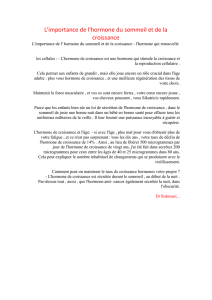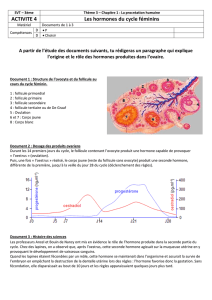Yves Combarnous - Académie d`Agriculture de France
publicité
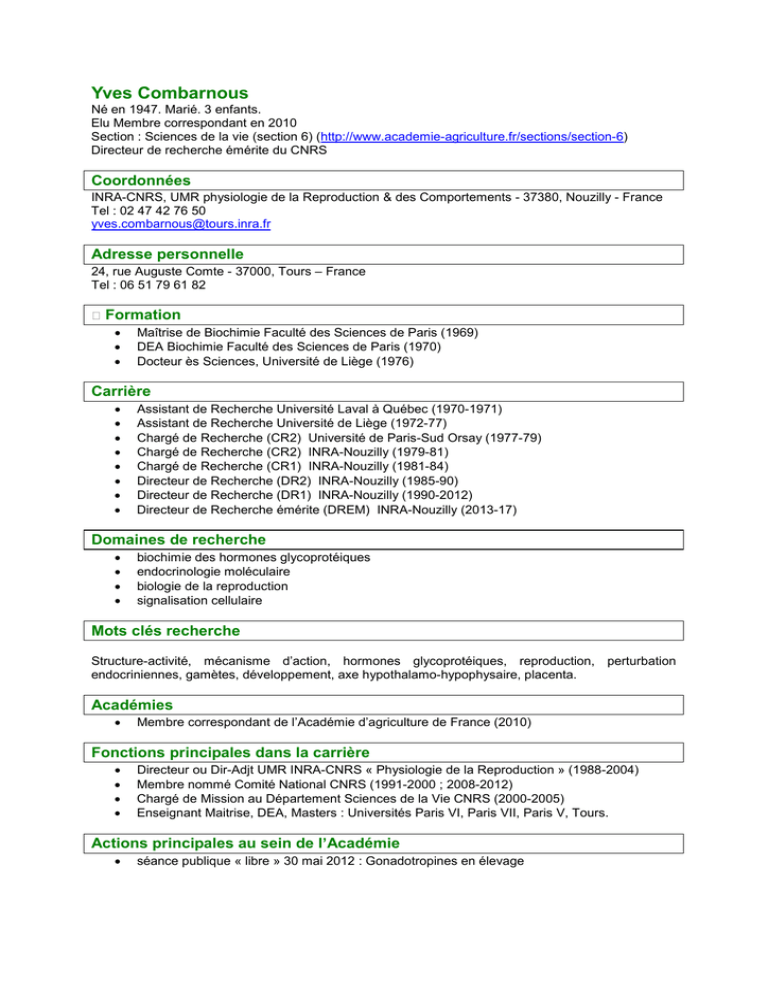
Yves Combarnous Né en 1947. Marié. 3 enfants. Elu Membre correspondant en 2010 Section : Sciences de la vie (section 6) (http://www.academie-agriculture.fr/sections/section-6) Directeur de recherche émérite du CNRS Coordonnées INRA-CNRS, UMR physiologie de la Reproduction & des Comportements - 37380, Nouzilly - France Tel : 02 47 42 76 50 [email protected] Adresse personnelle 24, rue Auguste Comte - 37000, Tours – France Tel : 06 51 79 61 82 Formation • • • Maîtrise de Biochimie Faculté des Sciences de Paris (1969) DEA Biochimie Faculté des Sciences de Paris (1970) Docteur ès Sciences, Université de Liège (1976) Carrière • • • • • • • • Assistant de Recherche Université Laval à Québec (1970-1971) Assistant de Recherche Université de Liège (1972-77) Chargé de Recherche (CR2) Université de Paris-Sud Orsay (1977-79) Chargé de Recherche (CR2) INRA-Nouzilly (1979-81) Chargé de Recherche (CR1) INRA-Nouzilly (1981-84) Directeur de Recherche (DR2) INRA-Nouzilly (1985-90) Directeur de Recherche (DR1) INRA-Nouzilly (1990-2012) Directeur de Recherche émérite (DREM) INRA-Nouzilly (2013-17) Domaines de recherche • • • • biochimie des hormones glycoprotéiques endocrinologie moléculaire biologie de la reproduction signalisation cellulaire Mots clés recherche Structure-activité, mécanisme d’action, hormones glycoprotéiques, reproduction, perturbation endocriniennes, gamètes, développement, axe hypothalamo-hypophysaire, placenta. Académies • Membre correspondant de l’Académie d’agriculture de France (2010) Fonctions principales dans la carrière • • • • Directeur ou Dir-Adjt UMR INRA-CNRS « Physiologie de la Reproduction » (1988-2004) Membre nommé Comité National CNRS (1991-2000 ; 2008-2012) Chargé de Mission au Département Sciences de la Vie CNRS (2000-2005) Enseignant Maitrise, DEA, Masters : Universités Paris VI, Paris VII, Paris V, Tours. Actions principales au sein de l’Académie • séance publique « libre » 30 mai 2012 : Gonadotropines en élevage Publications 124 articles dans revues à comité de lecture. http://www.researchgate.net/profile/Yves_Combarnous Quelques articles sélectionnés : • HERMIER C., COMBARNOUS Y. & JUTISZ M. (1971). Role of a regulating protein and molecular oxygen in the mechanism of action of luteinizing hormone. Biochim. Biophys. Acta 244, 625-633 • COMBARNOUS Y. and NABEDRYK-VIALA E. (1978) Porcine Lutropin: A study of the association of its subunits by hydrogen-deuterium exchange Biochem Biophys Res Comm 30, 1119-1124 • COMBARNOUS Y, HENGÉ M.H. (1981). Equine Follicle-Stimulating Hormone. Purification, acid-dissociation and binding to equine testicular tissue. J. Biol. Chem. 256, 9567-9572 • COMBARNOUS Y., GUILLOU F., MARTINAT N. (1984). Comparison of in vitro FollicleStimulating (FSH) activity of equine gonadotropins Luteinizing Hormone, FSH and Chorionic Gonadotropin. Endocrinology 115, 1821-1827 • BEGEOT M, HEMING F.J., DUBOIS P.M., COMBARNOUS Y., DUBOIS M.P., AUBERT M.L. (1984). Induction of pituitary lactotrope differentiation by luteinizing hormone α-subunit. Science 226, 566-568 • COMBARNOUS Y. (1992). Molecular basis of the specificity of binding of glycoprotein hormones to their receptors. Endocrine Reviews 13, 670-691 • RICHARD F., MARTINAT N., REMY J.J., SALESSE R. and COMBARNOUS Y. (1997). Cloning, sequencing and in vitro functional expression of recombinant donkey FollicleStimulating Hormone (dkFSH-R): a new insight in the binding specificity of gonadotropin receptors. J. Mol. Endocr. 18:193-202 • LETEUX C, CHEI W, LOVELESS RW, YUEN CT, UHLIN-HANSEN L, COMBARNOUS Y, MARIC SC, MISULOVIN Z, NUSSENZWEIG MC, FEIZI T (2000) The cystein-rich domain of the Macrophage Mannose Receptor is a multispecific lectin which recognizes chondroitin a x sulfates A and B and sulfated oligosaccharides of blood-groop Lewis and Lewis types in addition to the sulfated N-glycans of Luteinizing Hormone. J. Exp. Med 191:1117-1126 • BELGHAZI M, KLETT D, CAHOREAU C, COMBARNOUS Y (2006) Nitro-ThioCyanoBenzoic acid (NTCB) reactivity of cysteines β100 and β110 in porcine Luteinizing Hormone : metastability and hypothetical isomerization of the two disulfide bridges of its β-subunit seatbelt. Mol. Cell. Endocr. 247: 175-182 • KLETT D, CAHOREAU C., VILLERET M., COMBARNOUS Y (2010) Effect of Pharmaceutical Potential Endocrine Disruptor Compounds on Protein Disulfide Isomerase Reductase Activity using Di-Eosin-Oxidized-Glutathion. PLoSOne 5:e9507 • CAHOREAU C, KLETT D, COMBARNOUS Y. (2015) Structure-function relationships of glycoprotein hormones and their subunits' ancestors. Front Endocrinol. 6:26. Review Livres • • • • • • Communications et signalisations cellulaires 4eme ed. de Yves Combarnous (4 octobre 2013) Communications et signalisations cellulaires 3eme ed. de Yves Combarnous (16 février 2004) Les Hormones de Yves Combarnous Que sais-je? N°63 (1 octobre 1998) Les Gonadotropines Y. Combarnous & P. Volland-Nail eds (3eme trim 1997) Biochimie des communications cellulaires. 2eme ed. : Hormones, neuromédiateurs, cytokines, facteurs de croissance de Yves Combarnous (1 novembre 1996) Biochimie des communications cellulaires 1ere ed : Hormones, neuromédiateurs, cytokines, facteurs de croissance de Yves Combarnous (1 septembre 1994) Brevets & partenariat industriel • 1 brevet international • Contrats de Recherche, de Consultance et de Prestations de service avec Sociétés Pharmaceutiques sur les caractérisations physicochimiques, immunologiques et biologiques des gonadotropines.
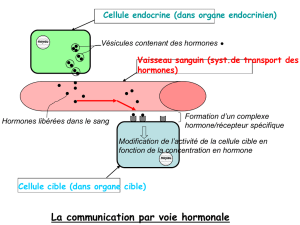
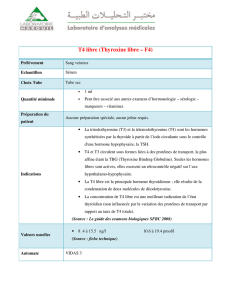
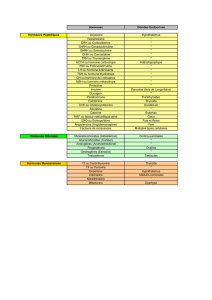
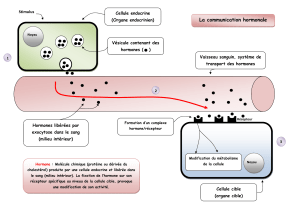
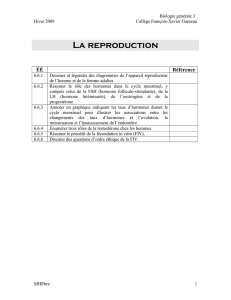

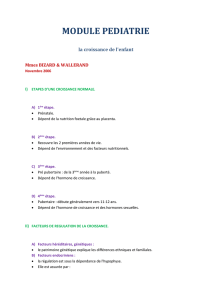
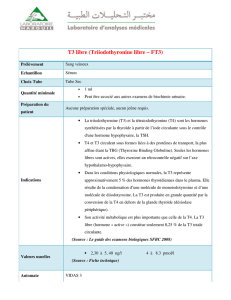
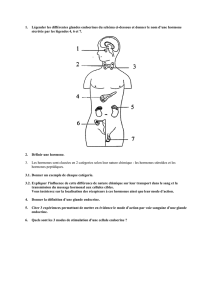
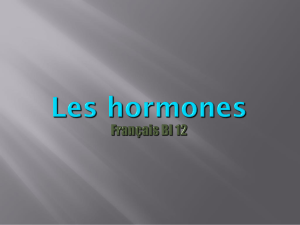

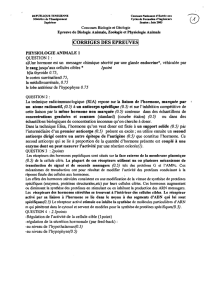
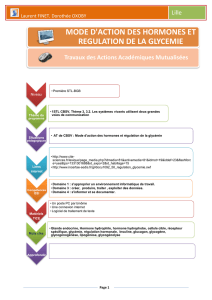
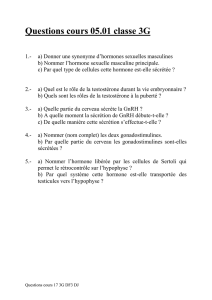
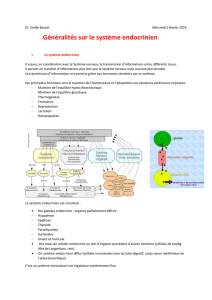
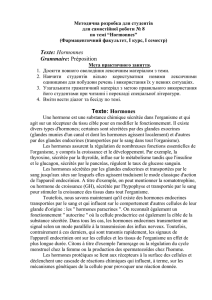
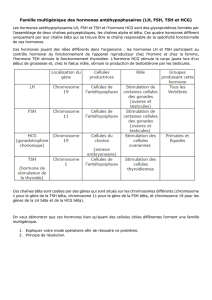
![Agence Comptable[2]](http://s1.studylibfr.com/store/data/000190145_1-d06ae78a9b3b8b79ebdfbed7139af760-300x300.png)
